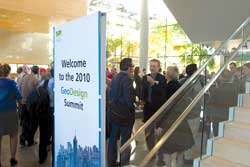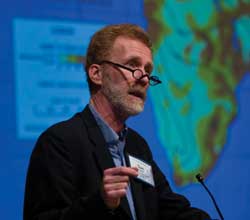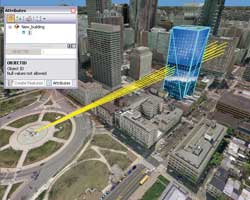ArcUser Online
Dangermond and a group of thought leaders from academia and a variety of professions believe it's time to better integrate geospatial technologies such as GIS with design to deal with the planet's most pressing problems. To jump-start that process, the 2010 GeoDesign Summit, sponsored by the University of California, Santa Barbara; the University of Redlands; and Esri, was held January 8�10 at Esri's conference center in Redlands, California. More than 170 academics and professionals from fields such as geography, architecture, GIS, urban planning, engineering, conservation, and forestry attended the event. Besides listening to keynotes and Lightning Talks (i.e., presentations lasting only a few minutes) on GeoDesign and how it's being used, attendees participated in "idea labs" for creating agendas for topics such as GeoDesign theories, education, future technologies, 3D visualization, and analysis in design. The Wikipedia entry they created to define GeoDesign reads, in part: "GeoDesign is a set of techniques and enabling technologies for planning built and natural environments in an integrated process, including project conceptualization, analysis, design specification, stakeholder participation and collaboration, design creation, simulation, and evaluation (among other stages)." The entry continues with a quote from "GeoDesign: Fundamental Principles and Routes Forward," the presentation Michael Flaxman made at the summit: "GeoDesign is a design and planning method which tightly couples the creation of design proposals with impact simulations informed by geographic contexts." "We are at the beginning of what many of us see as a new field," said Thomas Fisher, dean of the College of Design at the University of Minnesota, in his Keynote Address. With the world facing what he called "exponentially increasing stress on the systems we depend on" such as natural ecosystems and building infrastructure, there's a great need to use spatial data and technologies in planning and design to tackle problems such as those associated with global warming, threats to species, and poorly designed infrastructure.
"One of the powers of GeoDesign is it makes these problems visual," he said. "They are easier to ignore when they are abstractions. Because we have been designing the world without data-rich knowledge of consequences, we've created a situation where we've made ourselves vulnerable as a species, which to me gives urgency to GeoDesign. This is something we don't have a lot of time to develop." The purpose of the two and a half day summit was to
In his opening remarks, Dangermond spoke about the great potential for GeoDesign, which is described by some as a pairing of design and GIS. It unites the art and creativity of design with the power and science of geospatial technology. GeoDesign can produce more informed, data-based design options and decisions. "The notion of integrating these two fields is very exciting to me. We have a kind of continuum from measurement to making decisions that integrates all of our ways of doing things into new processes," Dangermond told the gathering. Dangermond said accelerating improvements in geospatial technologies will hasten advances in GeoDesign. New design-friendly capabilities and tools in the upcoming release of ArcGIS 10 will help professionals apply GeoDesign methodologies to problems and challenges related to anything from climate change to pandemic diseases, environmental protection to food production, and resource conservation to infrastructure improvements. "Geospatial technology is migrating to the Web and will be used by practically everyone in some way or other," Dangermond said. This new style of serving geography will affect virtually everything that people do—not just a few researchers, GIS professionals, or those who work with geographic information. Improvements in GIS, the explosion of location-based services (LBS), faster computers, more bandwidth and storage, the boom in mobile devices, and the emergence of cloud computing will also speed GeoDesign along, according to Dangermond. While some people describe this as disruptive technology, for Dangermond, "it's just another step in the evolution in the enabling technology that allows us to bring these new ideas that will come out of this meeting to fruition. Organizations also are beginning to serve geographic knowledge, which is providing a new infrastructure to build on top of, hopefully, the design notions that come out of the summit." Dangermond continued, "Agencies will not be providing data files or maps. They will be providing services, and these services will be a new framework. Just like the Apple iPhone is providing a framework for all kinds of apps, these geospatial services—and the ability to build creative applications on top of them—will explode our field and the general interest in designing our future." Designer-Friendly GIS TechnologyMatthew Baker, Nathan Shephard, and Bern Szukalski from Esri demonstrated currently available tools and services and soon-to-be-released technology that will assist designers in their work.
Baker's demonstration focused on the modeling, sketching, and feedback capabilities in ArcGIS Desktop 10, set for release in the second quarter of 2010. To find the best areas suitable for redevelopment in Detroit, Michigan, he created a model that used public GIS data and extracted block group parcels in the city that met criteria such as high poverty rates, vacant properties, and high unemployment. He used basemaps available from ArcGIS Online, an Esri Web site that provides free maps and other resources for GIS applications. The model's results pointed Baker to key redevelopment areas. Baker then began sketching a new neighborhood using standard land-use symbols for neighborhood design, which will be available in future templates in the ArcGIS 10 editing tools. He received instant feedback on the suitability of his designs in the form of pie and bar charts that were based on the features he sketched using an ArcGIS 10 add-in called the Dynamic Charting tool. Every time new features are added to the map, the Dynamic Charting tool provides updates. Shephard demonstrated new design-friendly capabilities in the ArcGIS 3D Analyst extension to ArcGIS Desktop 10. These capabilities included template-based (sketch) editing in 3D; 3D vector analyses of line of sight; 3D object intersections and skylines; volumetric analysis of buildings, shadow impact, and visibility zones; and a template of a virtual city. The virtual city template provides a useful example of a well-defined 3D city. The four key elements of such a city are a topographic basemap, high-resolution imagery, an elevation surface, and 3D buildings. If the data is available, users can add other elements such as vegetation, streetlights, and park benches. "These new capabilities allow you to quickly and accurately solve 3D GIS problems, such as assessing the impact of a proposed building on your city or identifying areas of concern based on 3D topography," said Shephard. Szukalski showed the audience ArcGIS Online resources for GeoDesigners or Web mappers that serve as what he called an "excellent substrate" of content. "These new basemaps and others provide great maps you can use as is or to represent a great canvas for design or GIS work," said Szukalski. These resources include
Urgent Need for GeoDesignThe summit brought together thought leaders in GIS, architecture, design, conservation, and many other fields including Michael Goodchild, professor of geography at California State University, Santa Barbara; Carl Steinitz, research professor at the Graduate School of Design, Harvard University; Kim Tanzer, dean of the School of Architecture at the University of Virginia; and William B. Rogers, president and CEO of the Trust for Public Lands. They spoke on how GIS is being used in design today and on its great potential to integrate the creativity of design and the science of GIS. Fisher from the University of Minnesota spoke passionately of the urgency of the situation. Citing ideas put forth by the Pulitzer Prize-winning author Thomas Friedman and professor of psychology David Barash at the University of Washington, Fisher argued that humans have created a giant Ponzi scheme with the planet over the last several hundred years, sucking resources and exploiting labor to maintain a certain way of life. This has led to the creation of what Fisher described as "fracture-critical systems" like the one that led to the collapse of the Interstate 35W bridge in Minneapolis, Minnesota, in 2007. Other fracture-critical threats include the exponentially increasing atmospheric carbon accumulation and rapidly declining biodiversity. "Even the recent financial crisis grew out of a fracture-critical system," Fisher said. "We designed financial products such that we increased the debt . . . where a few investment banks go down and they bring the entire global financial community down with [them]," Fisher said. "It's a classic collapse of a fracture-critical system. There is a spatial component to this. The banks do not know where the debt lies. Here, too, GeoDesign can help us understand the flows of money spatially across the planet." Fisher called a fracture-critical system a metaphor for the world humans have designed for themselves. But he pointed out that innovations such as GeoDesign can help reverse the course. "A lot of what we have been designing—our cities, our buildings, our landscapes—have been designed without a lot of information about the consequences of our actions on other species, on distant populations, on future generations," he said. "As GeoDesign can bring data to bear on those design decisions, it will profoundly change the way we live and inhabit the planet. Through innovation, we can rethink the way in which we inhabit the planet, we can rethink the way we use resources, and we can prolong our ability to sustain ourselves. GeoDesign's time has come, and it's none too soon." Dangermond concurred. "We need this right now," he said. "We need to not only understand what's occurring on the planet, but we also need to take more proactive involvement in designing what occurs. Then we have to promote those designs, those creations, those in our mind's eye expressions, to the rest of society. That's the challenge." |


